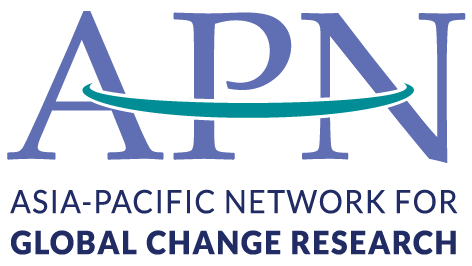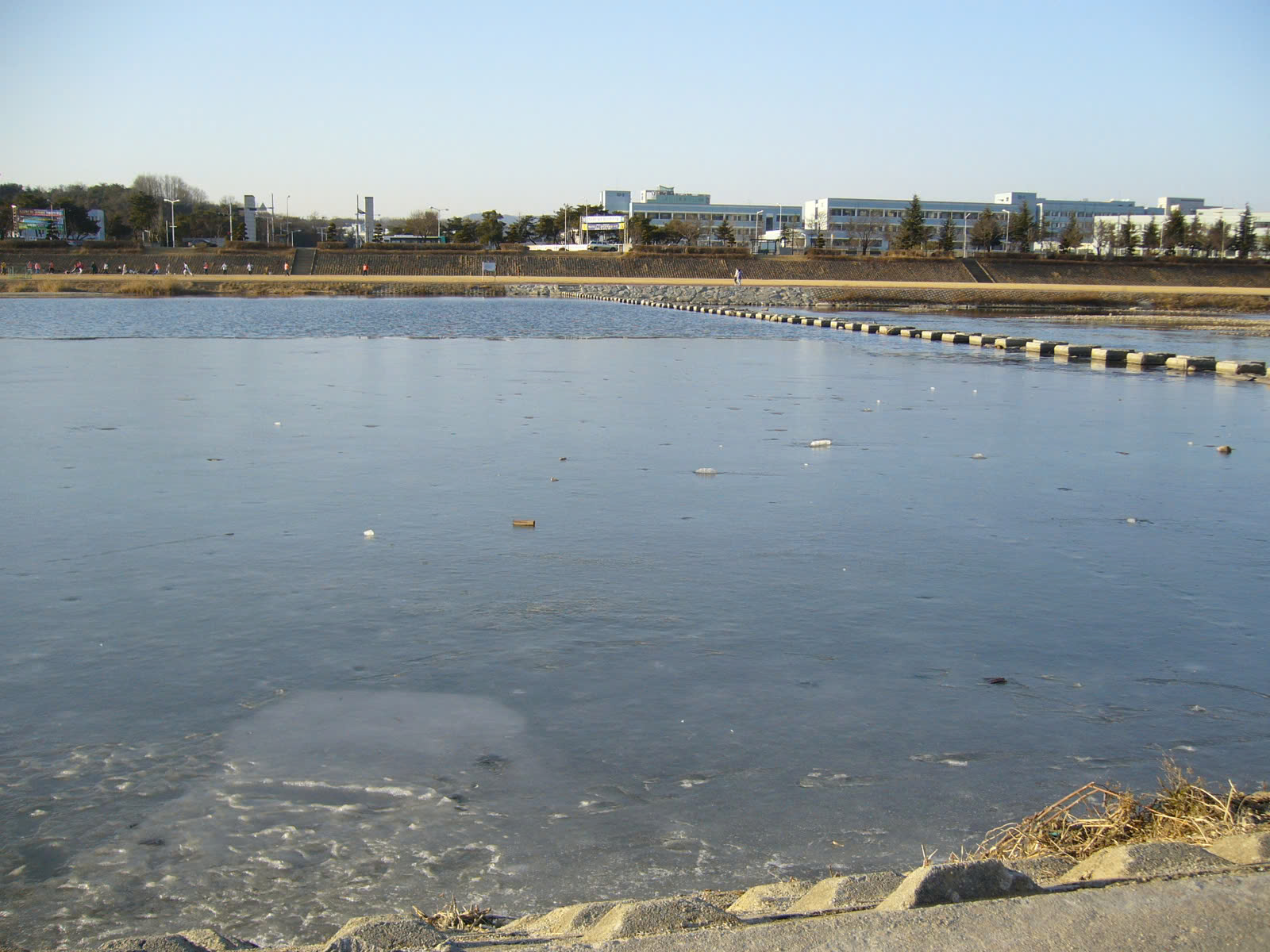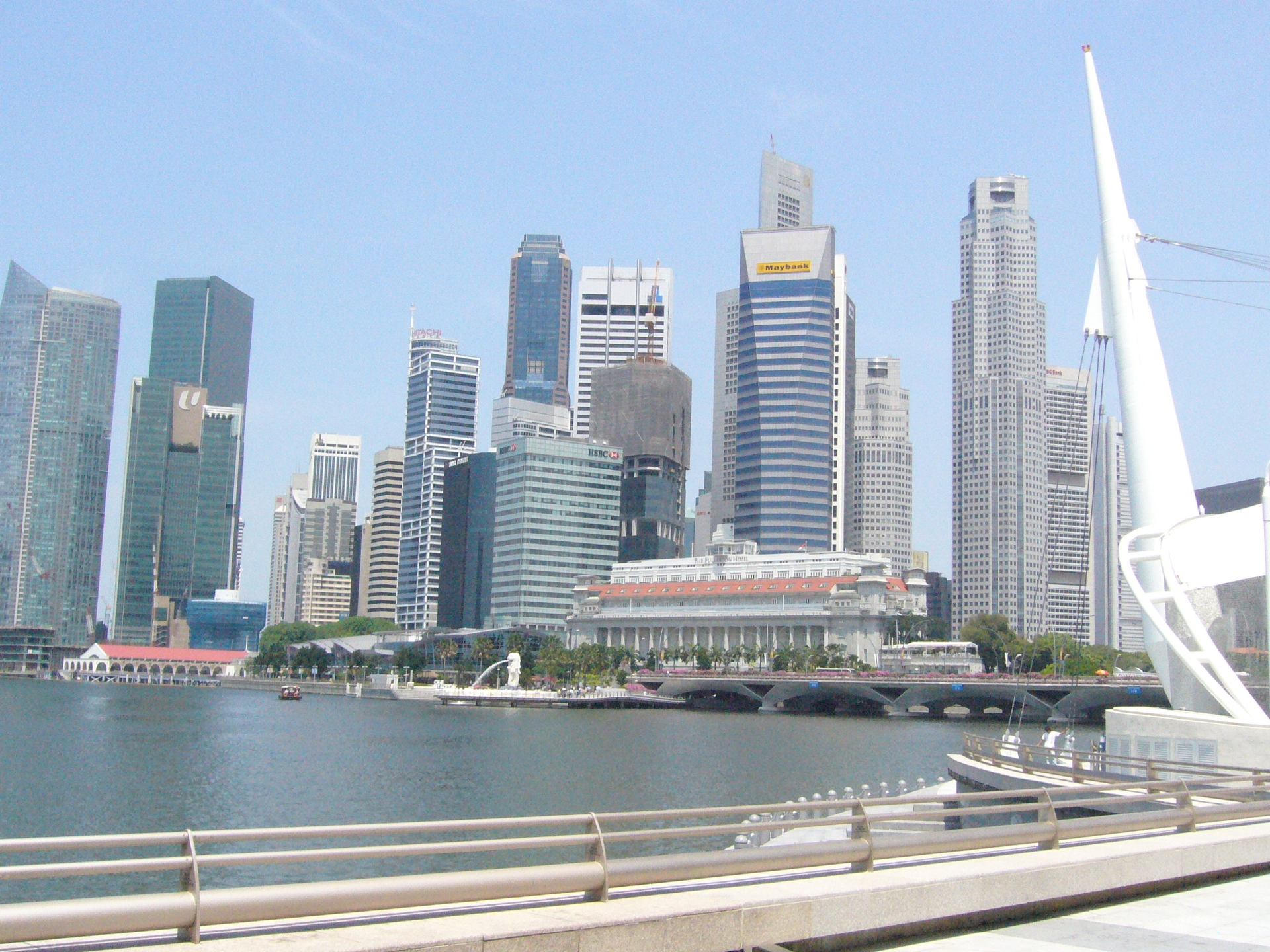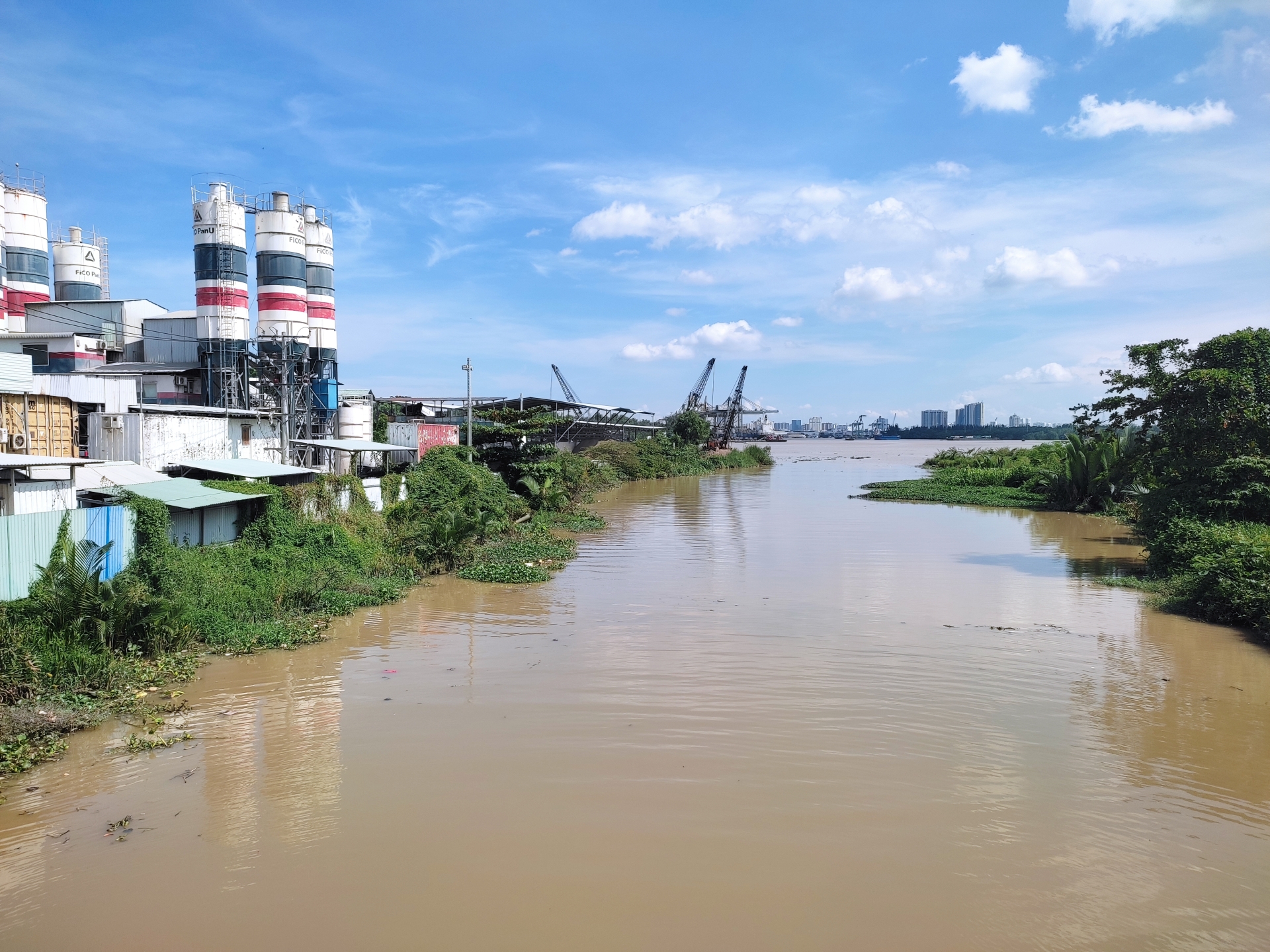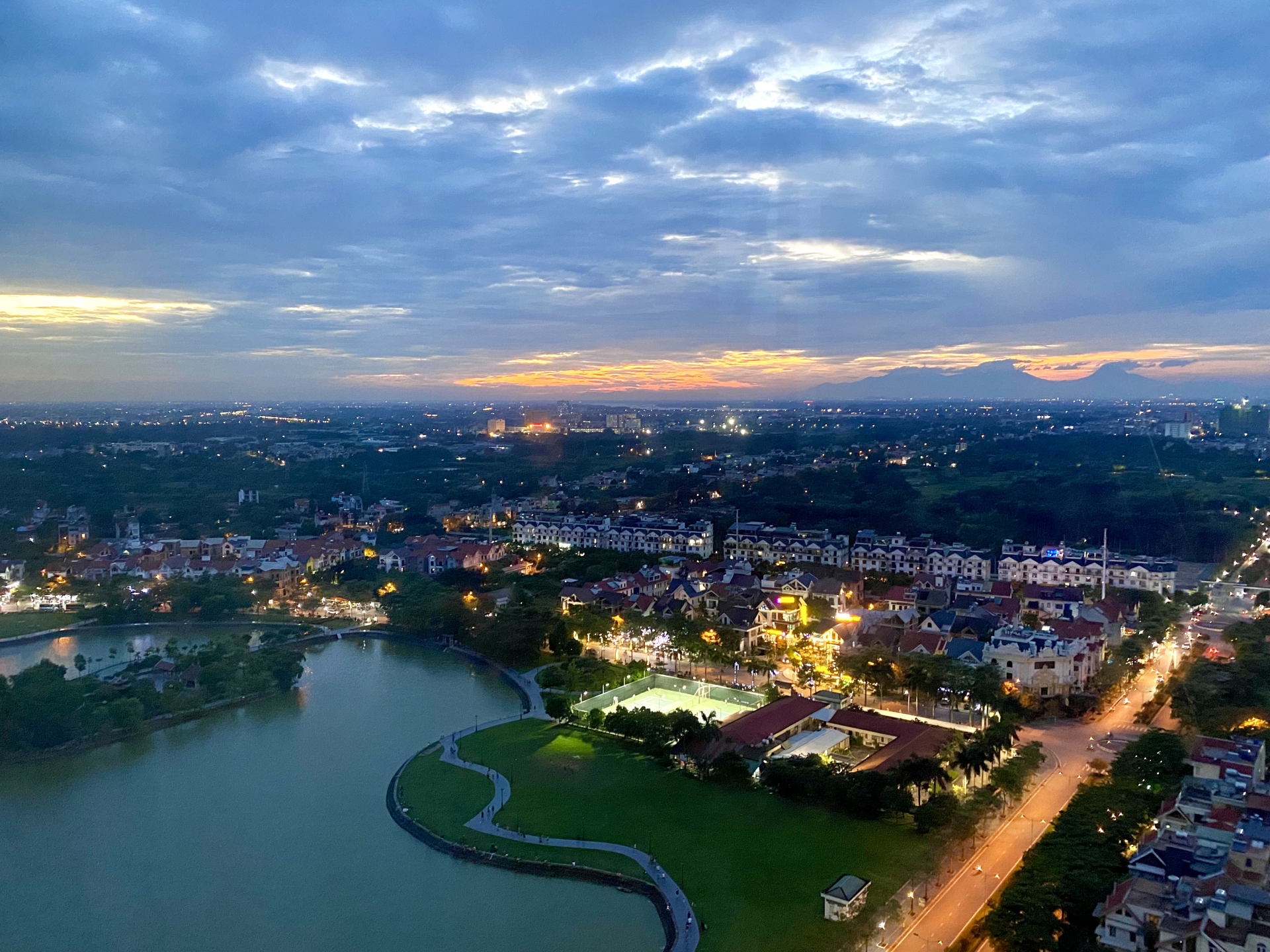Water quality in Phnom Penh city
Located in the Southeast Asia, Phnom Penh city is the capital and largest city of Cambodia, coverage the surface area of 692.46 km2. The population of the city is 2.1 million (13.9% of total population) with density of 3,136 people/km2 (2019). In Phnom Penh, there is a significant confluence known as the Chaktomuk Confluence, where the Mekong, Tonle Sap, and Bassac Rivers intersect (Figure 1). These rivers offer valuable freshwater and river ecosystems that are essential for sustaining environmental health, natural beauty, and supporting the rich cultural heritage of the people of Phnom Penh City. The hydrology of the Tonle Sap Lake is driven by the monsoonal flood regime of Mekong River (Kummu et al., 2014). This river system is quite unique compared to those of other cities, primarily due to the reverse flow of the Tonle Sap River between the wet and dry seasons. This phenomenon is driven by the difference in hydraulic head between Tonle Sap Lake (located northwest of Phnom Penh) and the Mekong River (Lu et al., 2014). The reverse flow of Tonle Sap Lake shares a contribution to the water discharge, water quality, and water related pollutant to Mekong River at Phnom Penh and the downstream, for example, 18% of water discharge, 3.7% of average annual sediment load, and 6 - 9% of nutrient load (Sok et al., 2021, 2022). Phnom Penh city consists or is surrounded by several lakes such as Tamouk (2,400 ha, at the northwestern part of the city, Choeung Ek (3,200 ha, at the north of the city, and Tumpun (47.5 ha surface area, located at the center of the city) Lakes. These lakes which are used for wastewater management, receive wastewater discharge from the Phnom Penh City. However, part of these lakes has been undergoing land reclamation to be transformed into residential and business areas as part of the city's development. About 10% of the city's waste is directly released into the Mekong River, while the remaining 90% is routed to four lakes around the city for natural treatment (Bravo de Guenni et al., 2024). Effluents from two lakes combined with industrial waste are pumped from Tumpun and Trabek into Cheung Ek lakes (Bravo de Guenni et al., 2024). The water then drains via two outlet streams, which flow into the Prek Thnout River and ultimately into the Bassac River. The impact of urbanization and anthropogenic activities in Phnom Penh on surface water quality is evident when examining the surrounding lakes and the changes in water quality in the Mekong and Tonle Bassac Rivers, both at Phnom Penh and in the downstream sections compared to the upstream portions of the Mekong River. Considering the significance of the Mekong River system, as well as Choeung Ek and Tamok Lakes, to Phnom Penh's freshwater resources, this section explores the water quality of these rivers and lakes to provide a comprehensive understanding of the current state of water quality in Phnom Penh.
Cheung Ek Lake receives wastewater from the city through an open channel, exhibiting significant seasonal variations in phosphate (PO₄⁻) and nitrate (NO₃⁻) levels. NO₃⁻ concentrations range from 0.11 to 0.66 mg/L, with a decrease during the dry season, suggesting urban runoff (Somara & Mihara, 2023). PO₄³⁻ levels show a marked reduction from 5.29 mg/L at the inlet to 1.42 mg/L at the outlet during the rainy season, likely due to agricultural activities on the lake's surface absorbing PO₄³⁻ (Somara & Mihara, 2023). The overall water quality of Cheung Ek Lake is poor according to the water quality index assessment, where the primary sources are from wastewater from the city (Bravo de Guenni et al., 2024; Somara & Mihara, 2023). However, water quality in the northern part of the lake, which directly receives municipal wastewater, is poorer than in the southern part, both during the rainy and dry seasons (Bravo de Guenni et al., 2024; Somara & Mihara, 2023). Similarly, pollution in Tamouk Lake is primarily attributed to effluents from over 50 aquaculture farms and Phnom Penh wastewater discharged via two urban canals. These pollutants affect the lake's water quality in both dry and rainy seasons. The lake experiences seasonal variations in pH, electrical conductivity (EC), total suspended solids (TSS), and nutrient levels. Notably, sites near aquaculture farms and wastewater canals exhibit higher levels of chemical oxygen demand (COD) and ammonia (NH3+) (Chan et al., 2022). Average values of COD and NH3+ were 46 mg/L and 9.7 mg/L in the dry season and 76.5 mg/L and 4.3 mg/L in the rainy season, respectively. Nutrient concentrations, including NO3− and phosphate PO₄⁻, are significantly higher during the rainy season, with maximum NO3− and PO4− concentrations of 10.5 mg/L and 10.9 mg/L. Despite some dilution by rainwater, based on water quality index assesement, the water quality remains poor to unsuitable for drinking water throughout the year due to consistent pollutant discharge (Chan et al., 2022). Although there are no specific studies on Tumpun Lake, its water quality is expected to be similar to that of Cheung Ek and Tamouk Lakes. These lakes are considered to effectively remove pollutants in both seasons, making them valuable natural wastewater treatment systems for Phnom Penh City (Sovann et al., 2015).
The current water quality of Mekong River at Phnom Penh and the downstream were classified in good condition considering their biotic and abiotic water quality indices (Sor et al., 2021). However, the trend in water quality of the Lower Mekong Basin including Phnom Penh areas and the Tonle Sap deteriorated in the 2010s compared to the 2000s (Chea et al., 2016; Sor et al., 2021). This degradation in water quality has been primarily attributed to anthropogenic activities such as urbanization, agricultural expansion, plastic waste, hydropower dam development, and deforestation (Tromboni et al., 2021). Changes in water quality have also been closely aligned with hydrological changes, as highlighted by (Chua et al., 2022). Additionally, the sediment and nutrient loading, the important water quality indicator supporting ecosystem, also in decrease trend. For example, an analysis of the sediment and nitrate loads in the Mekong River at Chroy Changva, Phnom Penh, from 1995 to 2016, shows a decreasing trend in nitrate levels, although no significant changes in the flow were observed (Sok et al., 2021, 2022). These trends are expected to continue due to the anthropogenic pressure and hydropower dam development. For example, under a hydropower development scenario, the total phosphorus transport in the Mekong mainstream at Kratie, Cambodia, is projected to decrease by 47 to 53%, while nitrogen transport is expected to decline by 57 to 62% (Piman & Shrestha, 2017).
Across environmental mediums, microplastics are pervasive in both freshwater and marine environment, including water columns, sediments, and biota. In Southeast Asia, microplastic concentrations in seawater range from 0.13 to 11,100 items/L, which are comparable to levels recorded in the Arctic Ocean and Santa Monica Bay (Curren et al., 2021). In Phnom Penh, assessments of microplastic pollution in the Mekong and Tonle Sap Rivers revealed that the total microplastic concentration was 1,180.5 ± 158 items/L for the Mekong River and 1,463 ± 126 items/L for the Tonle Sap River, with the dominant size fraction being 6.5–20 µm. These findings indicate higher microplastic levels in the Tonle Sap River (Babel & Dork, 2021). The higher concentration of microplastics in the Tonle Sap River compared to the Mekong River reflects the urban impact of Phnom Penh, particularly from wastewater discharge, as microplastic pollution is believed to originate from mismanaged solid waste and sewage effluents. Studies estimate that significant numbers of microplastic particles are released daily from wastewater treatment plants, contributing to the overall pollution load (Murphy et al., 2016; Strokal et al., 2023). Polyethylene terephthalate (PET) and polyethylene (PE) were identified as the dominant types of microplastics, with fragmented plastics more prevalent than fibers. Other studies have similarly reported polypropylene (PP), PE, and polystyrene (PS) as the major plastic types, often associated with single-use plastic items (Haberstroh et al., 2021).
Assessment of microplastics pollution and potential input from Phnom Penh city was yet no study base on our knowledge. However, we can learn from the investigation of microplastics. For instance, (van Emmerik et al., 2023) showed that in the dry season, floating plastic mass transport in the Mekong River's main branch ranged from 9.2 kg/day upstream to 563 kg/day downstream. While, Tonle Sap and Bassac Rivers exhibited transport rates between 21 and 400 kg/day and 22 and 500 kg/day, respectively. While in rainy season, the mass transport of plastics of Mekong River to downstream of Phnom Penh up to 6,800 kg/day, while the Bassac and Tonle Sap Rivers had transport rates of 500 and 2,800 kg/day, respectively. Overall, total plastic mass transport downstream of Phnom Penh (962 kg/day) was nearly 60% higher than upstream (606 kg/day) (Haberstroh et al., 2021; van Emmerik et al., 2023). The mass balance analysis indicates that more plastic enters the river system from Phnom Penh during the rainy season, with 42% of the city's plastic waste, equating to 89 g/day per capita, potentially ending up in the Mekong (Haberstroh et al., 2021). This underscores Phnom Penh's significant role as a major source for plastic pollution into the Mekong River system. On a broader scale, Phnom Penh contributes 1,527 tons of plastic annually to the Tonle Sap Basin, accounting for 83% of the total input of approximately 9,473 tons per year (Finnegan & Gouramanis, 2021). Plastic input into water bodies is primarily believed to originate from mismanaged solid waste, such as improper waste management and open dumping (Sari et al., 2022). However, Phnom Penh's waste collection rate is comparable to other Southeast Asian cities, standing at 80% (Ng et al., 2023). The increase in plastic waste in Phnom Penh and Cambodia is driven by the widespread production and consumption of plastic, which coincides with the country's economic transition after joining ASEAN in 1999 and the WTO in 2004 (Finnegan & Gouramanis, 2021).
On the other hand, pesticides have been widely used in Cambodia, with various types being employed across the country for agricultural purposes (Chem, 2023). A cross-sectional survey conducted at Boeung Cheung Ek Lake, a wastewater lake north of Phnom Penh, in 2010 revealed that farmers employed a range of pesticides, including both insecticides and fungicides (Chem, 2023; Jensen et al., 2011). Alarmingly, the use of highly hazardous pesticides such as Monocrotophos, Dichlorvos, and Methidathion, as well as the extremely hazardous pesticide Mevinphos, was reported. It is believed that pesticide runoff into water bodies is more prevalent in provinces with intensive agricultural activities compared to Phnom Penh, where commercial activities dominate. For instance, pesticide residues, including hexaconazole, pretilachlor, paclobutrazol, propiconazole, azoxystrobin, and fluquinconazole, were detected in drainage systems, rice fields, and mango farms south of Phnom Penh. However, these residues were not found in the Bassac River downstream of the city (Hak et al., 2021; Keo et al., 2022). In a related study, (Hak et al., 2021). Hak et al. (2021) identified 167 types of pesticides in the water of rice and mango farms, drainage systems, and tributaries of the Bassac River. Among these, persistent organic pollutants such as DDT, Dieldrin, and Endrin were also detected, raising concerns about their potential to leach into the river. Despite the presence of these pesticides in agricultural areas, only Chloroneb and Triadimefon were detected in the Bassac River, with concentrations of 0.94 ± 0.87 μg/L and 0.03 ± 0.02 μg/L, respectively (Hak et al., 2021). Other pesticides were not detected in the river during either the dry or rainy seasons, likely due to factors such as pollutant dilution, degradation, or limited transportation (Hak et al., 2021; Keo et al., 2022). Since the study areas are located approximately 40 km downstream of Phnom Penh, the findings suggest that there is no clear evidence of pesticide or POP contamination in surface waters attributable to activities within Phnom Penh.
To our knowledge, the concentrations and patterns of antibiotics and cyanotoxin in surface water in Phnom Penh have not yet been investigated. While the study for PFAS around Phnom Penh and in Cambodia were very limited, with only a one study investigated the concentration of PFAS in surface water around Phnom Penh or within the lower Mekong River Basin of Cambodia with coverage the Mekong and Bassac Rivers. Within 25 sampling sites (from 2022-2023) across lower Mekong basin, the concentration of total PFAS (sum of all targeted PFAS concentrations) were found in the range from 28.9 to 2,140 ng/L, with a median of 177 ng/L (Saftner et al., 2023). These concentrations were high compared to total PFAS of surface water of rivers in Tianjin and Weifang, China, which less than 80 ng/L (Yao et al., 2022), and freshwater in Southeast Asia (Baluyot et al., 2021). There is a clear evidence that Phnom Penh city contribute to the PFAS pollution in the river system, for instant, the results by (Saftner et al., 2023) showed that concentration of total PFAS was high around the potential effluent source of Phnom Penh city, including a wetland containing untreated sewage effluent and downstream from a textile manufacturing facility. Moreover, the concern about PFAS in the surface water of Cambodia not only aware around the Phnom Penh city, since total PFAS was also high in rural agricultural areas, including in the Bassac River and near a tributary's confluence with the Mekong River upstream of the city of Stung Treng in northern Cambodia (Saftner et al., 2023).
Based on all those fragmented knowledge, we can conclude that the water quality in Phnom Penh shows significant degradation, mirroring trends seen in water bodies Phnom Penh city, especially the Mekong River, due to anthropogenic activities such as urbanization and inadequate waste management. This degradation is reflected in decreasing nutrient and sediment loads, as well as increasing levels of emerging pollutants like microplastics and PFAS. The city's impact on the water quality of the Mekong River system is substantial, necessitating urgent interventions to address pollution sources and protect regional water resources.
References
Babel, S., & Dork, H. (2021). Identification of Micro-plastic Contamination in Drinking Water Treatment Plants in Phnom Penh, Cambodia. Journal of Engineering and Technological Sciences, 53(3), 210307. https://doi.org/10.5614/j.eng.technol.sci.2021.53.3.7
Baluyot, J. C., Reyes, E. M., & Velarde, M. C. (2021). Per- and polyfluoroalkyl substances (PFAS) as contaminants of emerging concern in Asia’s freshwater resources. Environmental Research, 197, 111122. https://doi.org/10.1016/j.envres.2021.111122
Bravo de Guenni, L., Lenczewski, M., Mallow, S. V., & Solanki, S. (2024). Assessing Water Quality Spatial Heterogeneity from Multiple Pollution Sources in the Boung Cheung Ek Wetland, Phnom Penh, Cambodia. Water, 16(1), Article 1. https://doi.org/10.3390/w16010004
Chan, R., Chan, R., Sok, T., Bun, S., Kaing, V., Mong, M., & Oeurng, C. (2022). RELATIVE DISTRIBUTION OF POLLUTANTS FROM URBAN CANAL AND AQUACULTURE FARM ONTO NATURAL WETLAND OF PHNOM PENH, CAMBODIA. Pollution Research, 767–777. https://doi.org/10.53550/PR.2022.v41i03.001
Chea, R., Grenouillet, G., & Lek, S. (2016). Evidence of water quality degradation in lower mekong basin revealed by self-organizing map. PLoS ONE, 11(1). https://doi.org/10.1371/journal.pone.0145527
Chem, C. (2023). Current status of pesticide practices and management approaches toward the safety and health of Cambodia: A review. Cambodia Journal of Basic and Applied Research, 5(2), Article 2. https://doi.org/10.61945/cjbar.2023.5.2.03
Chua, S. D. X., Lu, X. X., Oeurng, C., Sok, T., & Grundy-Warr, C. (2022). Drastic decline of flood pulse in the Cambodian floodplains (Mekong River and Tonle Sap system). Hydrology and Earth System Sciences, 26(3), 609–625. https://doi.org/10.5194/hess-26-609-2022
Curren, E., Kuwahara, V. S., Yoshida, T., & Leong, S. C. Y. (2021). Marine microplastics in the ASEAN region: A review of the current state of knowledge. Environmental Pollution, 288, 117776. https://doi.org/10.1016/j.envpol.2021.117776
Finnegan, A. M. D., & Gouramanis, C. (2021). Projected plastic waste loss scenarios between 2000 and 2030 into the largest freshwater-lake system in Southeast Asia. Scientific Reports, 11(1), 3897. https://doi.org/10.1038/s41598-021-83064-9
Haberstroh, C. J., Arias, M. E., Yin, Z., Sok, T., & Wang, M. C. (2021). Plastic transport in a complex confluence of the Mekong River in Cambodia. Environmental Research Letters, 16(9), 095009. https://doi.org/10.1088/1748-9326/ac2198
Hak, N., Keo, S., Long, C., Frick, M., Massuel, S., Phat, C., Chhuon, K., Lun, S., Siev, S., Doung, R., Venot, J.-P., & Eang, K. E. (2021). Pesticide Distribution in the Hydrological Compartment in Koh Thum.
Jensen, H. K., Konradsen, F., Jørs, E., Petersen, J. H., & Dalsgaard, A. (2011). Pesticide Use and Self-Reported Symptoms of Acute Pesticide Poisoning among Aquatic Farmers in Phnom Penh, Cambodia. Journal of Toxicology, 2011, 639814. https://doi.org/10.1155/2011/639814
Keo, S., Eang, K. E., Phat, C., Yoeun, S., Meak, L., Chhuon, K., & Massuel, S. (2022). Detection of Pesticide Residues in The Canal Irrigation System of The Upper Mekong Delta, Cambodia. Indonesian Journal of Limnology, 3(1), Article 1. https://doi.org/10.51264/inajl.v3i1.24
Kummu, M., Tes, S., Yin, S., Adamson, P., Józsa, J., Koponen, J., Richey, J., & Sarkkula, J. (2014). Water balance analysis for the Tonle Sap Lake-floodplain system. Hydrological Processes, 28(4), 1722–1733. https://doi.org/10.1002/hyp.9718
Lu, X., Kummu, M., & Oeurng, C. (2014). Reappraisal of sediment dynamics in the Lower Mekong River, Cambodia. Earth Surface Processes and Landforms, 39(14), 1855–1865. https://doi.org/10.1002/esp.3573
Murphy, F., Ewins, C., Carbonnier, F., & Quinn, B. (2016). Wastewater Treatment Works (WwTW) as a Source of Microplastics in the Aquatic Environment. Environmental Science & Technology, 50(11), 5800–5808. https://doi.org/10.1021/acs.est.5b05416
Ng, C. H., Mistoh, M. A., Teo, S. H., Galassi, A., Ibrahim, A., Sipaut, C. S., Foo, J., Seay, J., Taufiq‐Yap, Y. H., & Janaun, J. (2023). Plastic waste and microplastic issues in Southeast Asia. Frontiers in Environmental Science, 11. https://doi.org/10.3389/fenvs.2023.1142071
NIS. (2019). General Population Census of the Kingdom of Cambodia 2019. Ministry of Planning, Kingdom of Cambodia. https://www.nis.gov.kh/nis/Census2019/Provisional%20Population%20Census%202019_English_FINAL.pdf
Piman, T., & Shrestha, M. (2017). Case study on sediment in the Mekong River Basin: Current state and future trends. UNESCO and Stockholm Environment Institute (SEI).
Saftner, D. M., Arienzo, M. M., Chea, S., Minatre, K. L., Kozloski, R., Chandra, S., & Hogan, Z. (2023). Source Attribution of Per- and Polyfluoroalkyl Substances (PFAS) in Surface Waters of the Lower Mekong River Basin of Cambodia. 2023, H23Z-1904. AGU Fall Meeting Abstracts.
Sari, M. M., Andarani, P., Notodarmojo, S., Harryes, R. K., Nguyen, M. N., Yokota, K., & Inoue, T. (2022). Plastic pollution in the surface water in Jakarta, Indonesia. Marine Pollution Bulletin, 182, 114023. https://doi.org/10.1016/j.marpolbul.2022.114023
Sok, T., Oeurng, C., Kaing, V., Sauvage, S., Kondolf, G. M., & Sánchez-Pérez, J. M. (2021). Assessment of suspended sediment load variability in the Tonle Sap and Lower Mekong Rivers, Cambodia. CATENA, 202, 105291. https://doi.org/10.1016/j.catena.2021.105291
Sok, T., Oeurng, C., Kaing, V., Sauvage, S., Lu, X., & Pérez, J. M. S. (2022). Nutrient transport and exchange between the Mekong River and Tonle Sap Lake in Cambodia. Ecological Engineering, 176, 106527. https://doi.org/10.1016/j.ecoleng.2021.106527
Somara, O., & Mihara, M. (2023). Seasonal Changes of Water Quality in Cheung Ek Lake, Cambodia. International Journal of Environmental and Rural Development, 14–2.
Sor, R., Ngor, P. B., Soum, S., Chandra, S., Hogan, Z. S., & Null, S. E. (2021). Water Quality Degradation in the Lower Mekong Basin. Water, 13(11), Article 11. https://doi.org/10.3390/w13111555
Sovann, C., Irvine, K. N., Suthipong, S., Kok, S., & Chea, E. (2015). Dynamic Modeling to Assess Natural Wetlands Treatment of Wastewater in Phnom Penh, Cambodia: Towards an Eco-City Planning Tool. International Journal of Environment and Climate Change, 104–115. https://doi.org/10.9734/BJECC/2015/12101
Strokal, M., Vriend, P., Bak, M. P., Kroeze, C., Van Wijnen, J., & Van Emmerik, T. (2023). River export of macro- and microplastics to seas by sources worldwide. Nature Communications, 14(1), 4842. https://doi.org/10.1038/s41467-023-40501-9
Tromboni, F., Dilts, T. E., Null, S. E., Lohani, S., Ngor, P. B., Soum, S., Hogan, Z., & Chandra, S. (2021). Changing Land Use and Population Density Are Degrading Water Quality in the Lower Mekong Basin. Water, 13(14), Article 14. https://doi.org/10.3390/w13141948
van Emmerik, T. H. M., Schreyers, L. J., Mellink, Y. A. M., Sok, T., & Arias, M. E. (2023). Large variation in Mekong river plastic transport between wet and dry season. Frontiers in Environmental Science, 11. https://doi.org/10.3389/fenvs.2023.1173946
Yao, J., Wen, J., Li, H., & Yang, Y. (2022). Surface functional groups determine adsorption of pharmaceuticals and personal care products on polypropylene microplastics. Journal of Hazardous Materials, 423, 127131. https://doi.org/10.1016/J.JHAZMAT.2021.127131


